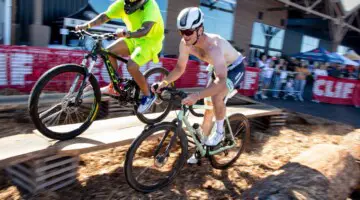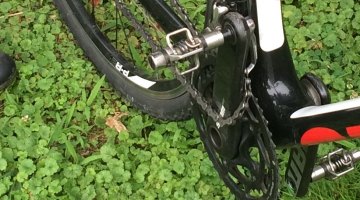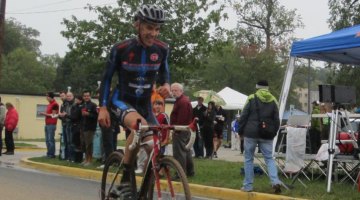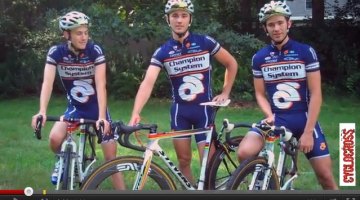We’ve continued our series of articles on training from Mike Birner. Part I was in Issue 3, and Part II is in our Issue 4. In this series of four articles, USAC Level 2 coach Mike Birner of Mid-Maryland Coaching (www.midmarylandcoaching.com) will guide your training through a successful cyclocross season. As a teaser of Issue 4 and so that more of you can implement his advice, we’re publishing this online as well.
Building ON the Base: September through November
Welcome back! In the last issue, you planned your periodized training and progressively built your workload through plenty of steady efforts at tempo, SST, threshold, and some vo2max levels. You started to run again and picked up the intensity there as well. Hopefully you also pulled out the ‘cross bike and got out on the trail or in the fields to test your bike-handling ability. This previous period is a key phase in developing your “engine” and giving your body the ability to handle the harder efforts to come. If you feel weak in any of the areas above, you should delay this next period a bit longer until you have the increased fitness necessary to begin the build period.
The Build Period:
The base period consisted of a significant amount of moderate intensity work. Now, as we enter the build period, volume decreases while intensity increases. This is especially important for cyclocross since the events are so short. Again, as you have heard before, quality over quantity should be your mantra. Plus, you will need extra time for recovery if you are putting in a full effort during your workouts. Your previous workouts focused on tempo to threshold intensities, and now you are ready to take a step up the ladder to primarily vo2max and anaerobic intensities.
A training plan during this period for a week that does not contain any racing might look like this:
| Monday | Tuesday | Wednesday | Thursday | Friday | Saturday | Sunday |
| Rest or active recovery | 1 hour: Microbursts or short intervals, each no more than 3 min in length | 1 hour:6 x 4 minute vo2max intervals | 1 hour, 30 min:2×30 minute SST intervals. Light to moderate running and/or plyometrics | Rest or active recovery | 2 hours: Race Specific Training-Set up simulated CX course, warm-up with skills work then do “hot laps” up to total race time | 2 hours:Zone 1/2 endurance ride-also a good day to take the cross bike on the trails |
You can adjust the total workout durations and interval lengths of this general plan to meet your ability and fitness level. This is also the time to address weaknesses in your cyclocross fitness. If you have trouble sustaining steady maximal efforts, you should include more SST, threshold, and vo2max work. If the steep grades are your weakness, find a good hill similar to what you might race on and do repeated hill attacks. We all have a tendency to keep plugging along in our comfort zone. Resist that temptation and deal with your weaknesses head-on. Odds are you will make greater gains with these often-neglected weaknesses than you will working the areas where you are already strong.
There are a couple of notes to mention about some of the above workouts. Vo2max efforts are difficult to do based on heart rate because of their variable nature. Ideally, you should use a power meter for this type of effort. Most people who perform this workout based on heart rate or perceived exertion tend to start out too hard. The goal of this workout is to accumulate as much time at vo2max (maximal oxygen uptake) as you can. Start too hard, and you will go anaerobic and not be able to accumulate time in your vo2max zone; start too easy, and you will never reach it. Also, recovery between intervals should be minimal (no more than the length of the interval) to allow your body to return to the vo2max zone as quickly as possible. With the anaerobic intervals (up to 3 min efforts-other than microbursts), take a full recovery by returning your heart rate back to zone 1. This will train your body to attain maximum output during the interval. Anaerobic intervals should be done earlier in the week at a time when you are more fully recovered. Doing these the day after a hard workout will not allow you to get the maximum output from your efforts.
During this period, it is likely you will start to include some racing in your schedule. Be sure to decide whether the race you are doing is just for training or for a key season race. If the race is just for training, then you can include it in your weekly plan as you normally would any other workout. If it is a race that you want to do well at, be sure to include a proper recovery and brief taper going into that event. Here’s an example of a week that might include a key race:
| Monday | Tuesday | Wednesday | Thursday | Friday | Saturday | Sunday |
| Rest or active recovery | 1 hour: Microbursts or short intervals | 1 hour:5 x 5 minute vo2max intervals | Rest or active recovery | 1 hour: Mostly Zone 1/2 with some openers-several 30 second full efforts | RACE! | 1 hours:Zone 1/2 endurance ride-mostly recovery |
Be aware that once you do start to include races into the program, you also may need to include more rest days following the event. You may not be ready for a hard workout on Tuesday like you normally would, especially if you raced the previous Sunday. More on this later.
Specificity:
This topic deserves its own section because specificity training is the place where so many beginning cyclists go wrong. Specificity is the concept of performing workouts that simulate, as close as possible, the specific demands of that event. For instance, you should not be doing five-hour zone 1/2 rides to prepare for a cyclocross race, just as you would not necessarily be doing anaerobic intervals to prepare for a century. The demands of each event are dramatically different and need to be prepared for in different ways. Think about the demands of the typical cyclocross race-a hard sprint at the beginning followed by short periods of maximal effort and many peak surges with very brief periods of coasting or recovery. How do we replicate that in training? The best way is to break it down into its different parts. Some workouts can address the technique and power associated with the starts. Other workouts, like the microbursts, will replicate the repeated maximal surges that most courses require. And finally, the vo2max and threshold workouts will not only have physiological benefits, but will also get you used to the pure suffering required in a cyclocross race.
My favorite workout to maximize specificity is to set up a 3-5 min/lap training course at a local school or park. Try to include everything a traditional course may have-run ups, barriers, corners, etc. After a good warm-up, including some skills practice, do two hot laps of the course. Accumulate at least as much time during these “intervals” as you would in your races. For example, if your event is 40 minutes, then do at least 4 x 2 hot laps of 5 minutes each lap in length. By doing this in the weeks prior to your first race, you will be sure to be better prepared than the rest of your competition-unless, of course, they are reading this same article!
Running:
Depending on the region you hail from, running during a cyclocross race may have a higher or lower degree of importance. Some areas of the country may require some serious running ability-especially the wetter courses-while others may not require more than a quick, flat dismount, a few steps, and a fast remount. You’ll have to decide how much running takes place and determine how much time to devote towards training for it. Here on the east coast, most of our courses involve short, steep run-ups and very little long, flat, running sections (though there are a couple). Therefore, to go back to the principle of specificity, developing some base fitness with your running, including stair or hill runs (and sprints), would be ideal. Should your courses demand longer running through sand or mud, building stamina through harder running workouts should be a priority.
Managing Recovery:
The other area where most cyclists (new and advanced) fall short is not allowing proper recovery. The best phrase I’ve heard relative to this is, “Workouts are designed to break the body down; recovery is what builds you back up.” So, if you continue to workout without taking adequate rest, you are only getting further from your peak performance. Some athletes find themselves in a constant state of overtraining and never realize it until an injury sidelines them. When they return from injury, they find themselves stronger than perhaps they ever were.
Probably the best method for tracking your recovery is to check your resting heart rate each day. To do this, count your pulse for 30 seconds and multiply by two. This will give you your beats per minute, and you can use this as a daily comparison for how your body is responding to the workouts. If you have a higher-than-normal heart rate on a certain day, it is quite likely that you have not recovered from your previous workouts. As you become more accustomed to reading your body’s cues, you may well be able to identify the early onset of an illness or other physical problems.
If you are proactive, there are methods you can use to speed your recovery, allowing you to possibly add in a few extra key workouts during the season. Beyond a healthy and proper diet, massage and stretching can give you that extra edge over the other riders. Also, your rest days do not have to be about sitting on the couch. A very light ride as well as a casual walk or swim can do wonders for getting the blood flow back into your legs and assisting the rebuilding process. Good recovery is often the difference between the top finishers and the rest of the pack.
So, there you are. You’re now well on your way into the start of the season and should be making gains week-to-week. Next time, the focus will be on the Peak/Race period-the final touches to your training plan for your best local championships and nationals results.
Glossary
| Workout Terminologies | Length | Intensity | Heart Rate Zone |
| Endurance | Hours | Easy/mod. | Zone 1/2 |
| Tempo | 30-120 min each | Moderate | Zone 3 |
| Sweet Spot Training (SST) | 15-50 min each | Mod/hard | Zone 3/4 |
| Maximum Steady State (MSS) / Threshold | 10-30 min each | Hard | Zone 4 |
| Vo2max | 3-8 min each | Very hard | Zone 5a |
| Anaerobic | Up to 3 min | All out | Zone 5b/c |




























